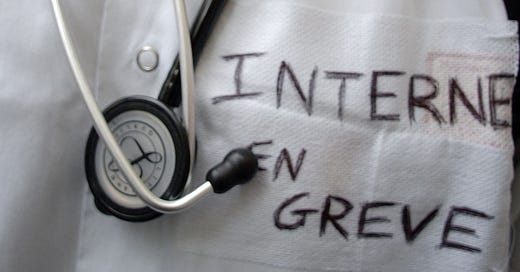Though you might think, from its revolutions, regicides and coups, that politics preoccupy the French, entire years can go by without anything more than the occasional manif, as we call a demonstration. This has been such a year, with barely a weekend on which placard-carrying marchers brought the city to a standstill. Perhaps, suggest theorists, what people enjoy is the spectacle, and the Olympics sated their taste.
It wasn’t always like that. When I first visited Paris in 1969, there were still signs of les evenements – the events of the year before; roads torn up for cobbles to throw at the police; tattered posters snarling Bourgeois, You Have Understood Nothing.
Once I moved here in 1989, demonstrations were a weekly occurence. The following somewhat breathless account comes from some notes recently unearthed from a forgotten file.
Mid-day on Pont Neuf, first Wednesday in February, 1990. Unexpectedly and unannounced, hundreds of men and women in white coats, most displaying hand-written labels announcing Interne en Greve (Intern on Strike), mass on the bridge and halt traffic. They are chefs du clinique: young hospital doctors, on strike against a law which limits the number of private clinics, the main career avenue of advancement for people who've already spent years on meagre pay in the government health service.
Meanwhile, at the Palais de Justice, just across the river, the trial is about to begin of a group responsible for killing more than twenty people in a series of bombings in Paris.
And coincidentally, as is customary at noon on the first Wednesday of every month, Paris’s emergency sirens and horns will sound as a test.
Today, all these things happen at once. As a chorus of hoots and howls blankets the city, three blue Renault vans containing the terrorists and police guards sweep around the corner onto Quai des Grands-Augustins, their he-hawing sirens adding to the din.
They swing onto Pont Neuf, to find it blocked by doctors waving banners advertising their grievances. Across the river, men of the CRS militia, in plain clothes but carrying sub-machine guns, sprint from the police HQ on Quai des Orfevres to clear a path. They don't count on the curiosity of the average Parisian who, whether on foot or in a car, stops to gawk. There's an instant jam in front of the bouquinistes at the corner of rue Dauphine, and the vans are caught in it.
What will happen next? We’ve seen enough movies to imagine a multitude of conclusions. A bomb thrown into the vans? A mass escape? Has it all been planned? Does the medical union shelter a terrorist confederate? Maybe the whole thing is a tournage ; a movie scene. Nobody would be surprised to see the raffish grin of Jean-Paul Belmondo somewhere in the melee.
No such luck. Reluctantly, the white coats part to let the vans through, and we on-lookers, the show over, drift back to our business. Crossing rue Dauphine, I realise that, on this spot, in April 1906, 46-year old Pierre Curie, co-discoverer of radium, slipped on the wet cobbles and died under the wheels of a horse-drawn cart. History repeats itself; first as tragedy, then as farce. Thanks for that, Karl Marx.






Glad you found these files. I remember the 1969 demonstrations. I was living in Lille.